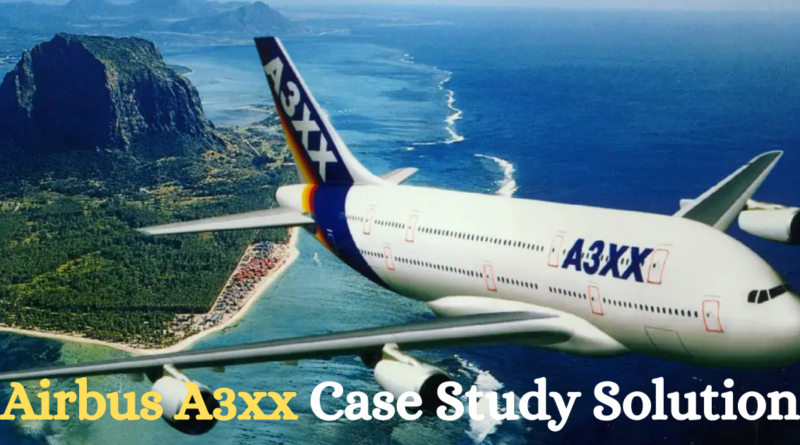Airbus A3xx Case Study Solution
Introduction
Airbus A3xx Case Study Solution ,Airbus was among the pioneers in manufacturing aircraft when it began as a consortium of German aerospace companies in 1973. From its inception, this innovative company has received recognition for design and technology innovations that have helped contribute to its success. Now, Airbus plans on unveiling their massive aircraft named A3XX, which should help further drive forward growth for their company.
Interest in A3XX
At first, Boeing and Airbus collaborated to research the possibility of producing a large aircraft. Still, Boeing decided against continuing after some time because it was too risky and expensive. On the contrary, Airbus pursued its plan and created the basic design in 1999 before further analysis revealed opportunities that increased their interest. There are multiple reasons why Boeing decided not to participate, while Airbus decided against creating the A3XX.
A3XX’s Future Demand
First and foremost, A3XX’s future demand expectations for its enormous jumbo jet are quite positive and in line with the projected success of this project. According to their forecasts of A3XX demand, prospects look very bright; already, 20 orders from various companies have been secured since their release into production, and it is anticipated that approximately 1500 aircraft will be required over twenty years for production and sale at 250 sales it would break even; although potentially they may sell 750 aircraft; this still represents significant profit potential of their project.
Airbus was also drawn to this project because A3XX features and specifications were far superior to all current aircraft in the industry, drawing them towards this project. A3XX was designed and constructed similarly to other Airbus models to facilitate pilot and crew operations of this new aircraft more smoothly.
This aircraft will boast significantly larger passenger capacities than existing aircraft, offering a distinct selling point as it can transport up to 1000 passengers versus B747’s 400-passenger capacity.
Furthermore, airlines can see this as an advantageous means to carry more than twice as many passengers as they currently can. A3XX would thus become more economical when looking at cost per passenger and spreading fixed operations costs over more passengers; although operation costs will likely exceed that of Boeing 747, the extra capacity available makes A3XX a more economical choice.
Other features of A3XX will make it more attractive for customers as its four engines provide greater security, particularly during an emergency. Regarding luxury and comfort, it offers additional space per seat with wider aisles and three decks featuring shower and lounge facilities to provide passengers with an added value experience.
Objectives
Airbus will set forth several objectives with their project of developing an aircraft, which has already been seen as costly and risky by Boeing as part of their competition. Therefore, they intend to achieve three main goals when continuing this endeavor.
Airbus could effectively compete in the market with Boeing by offering a new model with significantly better facilities than its competitors; this would give Airbus an edge and maintain its reputation of innovation within design and technology.
Airbus recognizes the value of financial returns as one of its top goals and plans to capitalize on them by continually exploring new projects, hoping that any success on one may allow the company to gain competitive advantages through creating financial returns for itself.
The company strives to make smart decisions when selecting projects to achieve these returns. To increase company profits, new projects are constantly evaluated – Airbus plans to exploit any opportunity where its competitor has fallen out with it to create a significant competitive advantage and bring significant financial returns back into its profits.
Airbus benefits greatly from the success of A3XX construction as one of its two aircraft manufacturing giants. Airbus hopes its success will enhance its position against its competitors and make it a market leader, among other objectives for building A3XX.
Case Solution
Threats
Airbus Industries recently proposed a strategy that will help it compete with Boeing. Unfortunately, due to the time lag between their proposal and implementation, there is always the threat that competition might intensify and their strategy fails.
Boeing adopted various tactics to maintain their position, such as cutting prices of 747s, which may divert customers away from purchasing A3XXs from Airbus; developing products that compete directly against A3XX; or enhancing current 747 aircraft, which might increase sales.
Any such moves by Boeing may adversely impact Airbus; therefore, it is important to take special precautions when adopting any strategy by Boeing that may cause adverse effects, and special attention should be paid here to avoid adverse impactful results for Airbus industries.
Boeing holds an undue dominance in the airline industry, providing only huge aircraft. Airbus intends to enter this market, but Boeing has begun legal proceedings against it; any attempt by Airbus at entry may lead to penalties that are likely severe enough for Airbus to consider, as well as its legal costs and possible penalties against Boeing. Therefore, Airbus should consider this before entering this sector.
Valuation
To evaluate a project, we use net present value. Equipment of the project depreciates over ten years using the straight-line depreciation method, and we assume a WACC of 12% while inflation should reach 2%; consequently, the net value is 24.29 million see exhibit three.
Airbus Industries considers their project worthwhile, with an undiscounted payback estimated as the sale of 250 planes, potential orders expected in 2006 estimated as 137, and the need for additional VLA estimated as 905.
As the VLA market has shown growth, the payback of this project should occur three or four months post-launch – quite impressive results! Estimates suggest that this project will earn operating margins between 15%-20%, which align with companyaEUR(tm) ‘s current IRR but are close to their Targeted IRR target; accordingly, sensitivity analyses should also be conducted.
Overall, undertaking this project will increase a company’s net worth due to an increasing demand for VLA and some early orders; accordingly, it would be prudent for them to pursue it.
Suitability of A3XX
Airbus hopes the A3XX aircraft can make them better compete directly and effectively against Boeing as their main competitor. Additionally, in its early stage, the company received approximately 52 orders of A3XX, and estimates indicate it may receive additional orders, bringing its potential total orders up to approximately 137 – suggesting the product would make an excellent addition to any market.
Estimations also project an anticipated rise in passenger traffic rate over the coming years, and demand for larger aircraft will increase accordingly. Current aircraft roots can often be very specific, thus necessitating more aircraft to combat this issue. Other spokesmen have commented on how airlines require aircraft with seating capacities of 700 to 800 and super jumbos. Boeing currently provides such aircraft, so Airbus Industries should capitalize on launching the A3XX.
Recommendation
Airbus Industries finances its projects via three main sources – Risk-sharing partners, launch aid, and their owners. Risk Sharing Partners need an equity stake in A3XX earnings for participation. Airbus Industries financed this project through equity.
Equity finance can be expensive since investors take on greater risks than debt holders. Debt holders’ returns remain unchanged regardless of a company’s profitability, and in case of liquidation, they receive their stake in preference to equity holders. Debt financing is an economical source of financing, and Airbus industries should utilize debt to finance projects with borrowing.
This will reduce the company’s cost of capital and lead to greater differences between project IRR and company cost of capital, thus decreasing project sensitivity and increasing the growth rate of a company. But before taking any such steps, it should first analyze the gearing and liquidity positions of the company.
Exhibit 4 shows Airbus Industries’ market share will expand over 20 years. Still, delivery service growth rates will decline more rapidly than support services sector growth rates. Airbus should also consider entering support services sector markets.
From exhibit five, we can observe that over the next nine years there will be the highest growth in aircraft with seating capacities ranging between 300 to 350, which indicates that A3XX may fail upon launch. Airbus should carefully examine its industry as its analysis seems too optimistic when compared with those from Boeing Company (for more on that comparison, refer to Exhibit 6).
Conclusion
Airbus operates within an established industry with significant customer and supplier influence but limited impact over suppliers. Internally, the company stands strong. There are ample opportunities to penetrate various markets, such as Asia, and sell online.
The proposed project is suitable to the company, as evidenced by its valuation and suitability analyses, which indicate its viability: the market requires such aircraft while financing options exist to make financing feasible, and technological innovation is available to assist with it. A project has a positive net present value and low payback period; IRR also appears positive, making the overall project beneficial to company wealth. It is also essential to perform a sensitivity analysis as the source of finance chosen by the company is more expensive.




